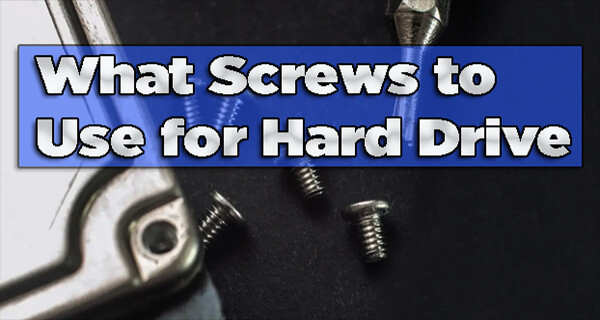Recently purchased a new hard drive and unsure about the appropriate screws for mounting it in your PC? Worry not, as you’ve come to the right place. Having replaced numerous hard drives and navigated various challenges. I possess the knowledge to guide you on the correct screws for your hard drive installation.

What Screws should I Use for Hard Drive?
For 3.5″ HDDs, you’ll need four 6-32 x 1/4″ screws. Typically, M3-size screws are used for hard drives. These M3 screws are smaller, have finer threads, and work exceptionally well for securing smaller components and thinner materials requiring strong fastening in tight spaces.
Screws serve the purpose of firmly anchoring the hard drive within the case’s drive cage. These fasteners come in various shapes and sizes and are essential for connecting different materials like plastic, metal, and wood.
Most computer cases have bays designed to accommodate 3.5″ internal drives. If your hard drive is a retail model, it usually includes 4-5 screws for this purpose.
Typically made of metal, screws with helical ridges play an essential role in securing physical hard disk drives inside computer host cases. These screws conform to the Unified Thread Standard (UTS) and are usually made of stainless steel with coarse threads suitable for manufacturing.
The #6-32 UNC hard drive screws are thicker and possess coarse threads, making them less suitable for fastening thicker materials and larger computer components. They generally provide less gripping strength.
You’ll need Phillips head, flat-head, or Torx head screwdrivers for these screws, depending on the screw head’s shape and size. Phillips head screwdrivers are the most common and versatile choice for various tasks, including electronics assembly and maintenance.
Metric M3-0.50 screw categories include Hex Bolt FT, PT, Socket cap, Low head, Button head, Socket flat, Phil flat, and Phil pan head. Before purchasing screws, make sure to determine the type your hard drive requires to ensure a secure fit.
Things to Remember Before Using Screws for Hard Drives?
Before proceeding with screws for hard drives, keep these important considerations in mind:
- Using the wrong screws can damage your hard drive if the diameter is incorrect.
- Tool less brackets provide an easier way to mount hard drives, but traditional screws offer more security.
- Tool less trays may work well for some systems, but screws ensure a more secure installation.
- Ensure you don’t block the breather hole on the hard drive, as it helps equalize internal pressure and release moisture.
- Leaving a small gap when mounting the drive system allows for better airflow and cooling.
- Position the hard drive in front of the fan for efficient cooling, as many brackets consist of two sections mounted to the computer casing.
In conclusion, selecting the appropriate screws for your hard drive is important for a successful installation. Typically, M3 screws for 3.5″ HDDs & M3 or #6-32 screws for SSDs and 2.5″ drives are commonly used. These screws play a vital role in securing your storage devices within your computer case.
Remember to consider the specific requirements of your hardware and case to ensure a secure and efficient setup. Properly chosen screws ensure that your hard drives stay firmly in place, contributing to the overall stability and functionality of your computer system.
FAQs –
Q. What size are computer hard drive screws?
Answer: Computer hard drive screws are typically sized at M3 (metric) or #6-32 UNC (Unified Thread Standard) for 3.5″ HDDs.
Q. Do you need screws for HDD?
Answer: Yes, screws are commonly used to securely mount hard disk drives (HDDs) inside computer cases.
Q. What screws do I need for my SSD?
Answer: SSDs often use M3 or #6-32 screws, similar to HDDs, for installation in desktop computer cases.
Q. What size screws are needed for a 2.5 hard drive mount?
Answer: To mount 2.5″ hard drives or SSDs, people typically use M3 screws, but the exact size may vary depending on the specific drive and case.
You may also like: Do All CPUs Have Integrated Graphics [Solved]
